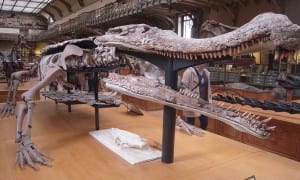Fossils, climate change and the future of life on Earth
By Dean W Veall, on 21 November 2013
Each year we celebrate the birth of the man who was the first Professor to teach evolution in an English university, the man who gave an astonishing 200 lectures a year and the man who lent his name to the Museum, Robert Edmond Grant. November 11th saw the 220th year since his birth and in honour we held our 17th Annual Grant Lecture on Tuesday, with dinosaurs, climate change and the future of life on our planet, it was one not to miss but in case you did here are the highlights.
Dr. Paul Upchurch and the titans of the Cretaceous
This year we had the great pleasure of inviting Dr. Paul Upchuch, one of the world’s leading dinosaur researchers to present the lecture. Paul works on the giant long necked sauropods such as the Saltasaurus that are icons of the Cretaceous.
Being a leading expert on the Cretaceous and for all the dinosaur lovers in the audience Paul couldn’t resist taking us briefly on a safari around the Cretaceous, (cue Jurassic Park theme), taking in his group of dinosaurs as well some familiar faces like Baryonynx:
to one of our hairier and cuter ancient relatives, Eomaia:
to the terrifyingly huge crocodile, Sarcosuchus:
Biodiversity Today
Back to today and the diversity of life on our planet, Paul talked us through what is referred to as the latitudinal biodiversity gradient (LBG) – the pattern of how diversity changes as you move from the poles to the equator. This is an important concept that has been key to his research in understanding the biogeographic patterns of life in the past – investigating the reasons why species live where they live. For the current day, the LBG shows that the diversity of life on our planet peaks in the tropics and decreases in the number of species the further you travel towards the poles. On this cold November morning who wouldn’t prefer to give up this sceptered isle for a warm beach in the Antilles? There are some exceptions of course, such as albatrosses, there is a greater number of species nearer the poles, those huge avian contrarians. Frogs and salamanders too.
The causes of the LBG remain largely unresolved, but climate appears to be a persuasive explanation, with the tropics having lower seasonality than the temperate zone which could lead to an increase rate of speciation due to species becoming specialised to a particular lifestyle or diet. So Paul’s research, funded by a Leverhulme grant, into understanding the causes and evolution of the LBG today will help in understanding and predicting future climatically driven biodiversity loss, the future of LIFE ON EARTH…..
Biodiversity in the Past
The LBG we see today of a tropical peak in biodiversity has been suggested to have been present for around 500 million years, but has changed on numerous occasions during this time so how can climate be a driving factor? Paul and his team took into account studies that corrected for sampling bias, plus biases such as human collecting effort and amount of available fossil material, to investigate biodiversity in the past and whether the pattern we see today was the same through deep time.
Paul presented three studies using fossil evidence that looked at marine invertebrates during the late Ordovician (458-423 Mya), dinosaurs during the Cretaceous (237-66 Mya) and insects from the early Eocene (53 Mya) . There appears to be either a peak of biodiversity at the temperate regions for dinosaurs and insects and only a slightly higher variety of marine invertebrates at the tropics. All of which are contrary to the gradient today. As all these periods coincided with warm periods this would suggest there is a relationship between the global climatic regime and the nature of the LBG. During ‘icehouse intervals’, when there is a permanent polar ice cap like today, the tropics might act as a refuge for species from the advancing ice but during ‘greenhouse intervals’ the tropics might simply have become too hot for many species leading to dispersal to the temperate zones or extinction.
In short – diversity peaks in the tropics in icehouse worlds and in temperate regions in greenhouse worlds. What does that mean for our warming planet today?
Biodiversity in the Future
Paul’s research helps look at biodiversity across space and time and offers insight into how scientists might model how species respond to the threat from climate change. Paul and his team suggest that current models of a pole-ward migration and time shifts in events such as migrant arrival times, nesting and hibernation might be too simplistic. Predictions of how the natural world responds to climatically driven environmental change should look deeper back in time to help understand the future distribution of species, it may see a return to a temperate peak or a shallower difference in biodiversity between the tropics and the temperate zones when the land mass of the tropics is taken into consideration. With all that said, we shouldn’t forget that previous diversity responses to changing climates happened in the absence of human activity.
Dean Veall is Learning and Access Officer at the Grant Museum of Zoology
 Close
Close






